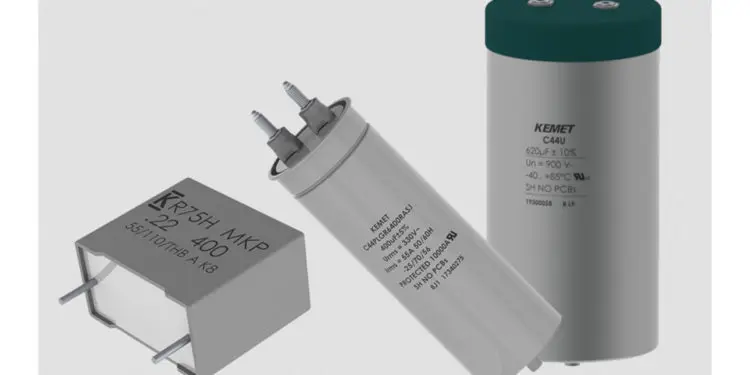KEMET, a subsidiary of Yageo Corporation, a leading global supplier of electronic components, today announces three new series of metallized polypropylene dielectric film capacitors: C44U-M, C44P-R, and R75H.
Constructed with an aluminum canister design, both the C44U-M and C44P-R power film series address the increasing demand for high-power conversion systems in green energy and industrial applications. These capacitors also support power conversion in energy storage systems, IGBT and wide bandgap (WBG) semiconductor devices. The R75H series, a radial box pulse capacitor, is similar in that it supports these applications, but also addresses the automotive sector with its high voltage, AEC-Q200 certified design.
The latest C44U-M series features a DC-Link and DC filter power film capacitor designed for high-power conversion systems applications in green energy, industrial, and energy storage systems. It supports DC networks and proportionally supplies high current based on circuit needs or load demands—a common characteristic in wind, solar, and storage energy technologies.
Its high DC voltage load capability (1,800 VDC) and high ripple current make this UL810-certified capacitor optimal for high capacitance while minimizing ESR. Similarly, the new C44P-R series is UL-810-certified and features high current capability for input and output AC filtering (up to 1,000 VAC) in solar converters, wind turbines, uninterruptible power supplies, and power factor correction systems. These cylindrical aluminum canister capacitors allow for higher energy density, extended life, reliability, and quality constructions due to our fully vertically integrated manufacturing facility in Bulgaria.
Designed with a radial box style for PCB mounting, the R75H Pulse series includes the same high energy density, extended life, and reliability benefits. This series meets one of the most rigorous reliability standards in the industry with its high voltage range (up to 2,000 VDC), high capacitance range, high dv/dt capability, and AEC-Q200 certified design.
These automotive-grade capacitors can support power conversion for on-board electronics systems and on-board battery management systems in vehicles, micro-inverters in solar panels, and WBG semiconductor devices in power supply systems. This series is designed for versatility in harsh conditions due to its THB (Temperature Humidity Bias) test capability of up to 85 ºC/ 85 R.H and operating temperature up to 125°C. Its high temperature capability is well-suited for applications that require miniaturization and fewer capacitors due to elevated temperatures and frequencies, such as resonant tank circuits with WBG semiconductor components.
These film capacitors launch at a time when renewable (green) energy and technologies are growing at a steady pace. In the International Energy Agency’s (IEA) “Renewables 2019” report*, the total global renewable-based power capacity will grow by 50 percent between 2019 and 2024. Solar photovoltaics technology, utilized by solar panels, accounts for over half of the growth, while onshore wind technology accounts for 25 percent of the growth. With major growth in China specifically, Asia accounts for most of the global renewable capacity expansion over the forecast period. Along the same line in automotive technologies, the market for on-board chargers for electric vehicles is estimated to reach $10.8 billion by 2027 with a CAGR of 22.5% from 2020 to 2027*.
The C44U-M, C44P-R, and R75H series are available immediately via KEMET distributors. To learn more about these power conversion technologies, visit https://www.kemet.com/en/us/applications/power-conversion.html.
*Sources:
Renewables 2019 by IEA, October 2019
Electric Vehicle On Board Charger Market by Power Output, Vehicle Type, and Propulsion Type: Global Opportunity Analysis and Industry Forecast, 2020–2027 by Allied Market Research, July 2020































